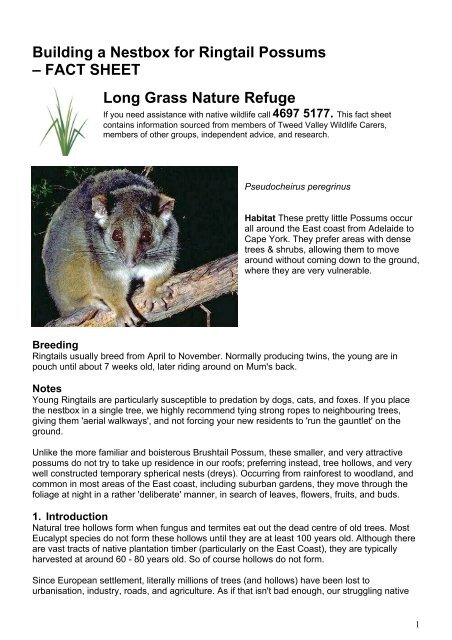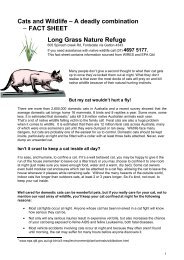Building a nestbox for Ringtail Possums - Rocklily Wombats
Building a nestbox for Ringtail Possums - Rocklily Wombats
Building a nestbox for Ringtail Possums - Rocklily Wombats
You also want an ePaper? Increase the reach of your titles
YUMPU automatically turns print PDFs into web optimized ePapers that Google loves.
<strong>Building</strong> a Nestbox <strong>for</strong> <strong>Ringtail</strong> <strong>Possums</strong><br />
– FACT SHEET<br />
Long Grass Nature Refuge<br />
If you need assistance with native wildlife call 4697 5177. This fact sheet<br />
contains in<strong>for</strong>mation sourced from members of Tweed Valley Wildlife Carers,<br />
members of other groups, independent advice, and research.<br />
Pseudocheirus peregrinus<br />
Habitat These pretty little <strong>Possums</strong> occur<br />
all around the East coast from Adelaide to<br />
Cape York. They prefer areas with dense<br />
trees & shrubs, allowing them to move<br />
around without coming down to the ground,<br />
where they are very vulnerable.<br />
Breeding<br />
<strong>Ringtail</strong>s usually breed from April to November. Normally producing twins, the young are in<br />
pouch until about 7 weeks old, later riding around on Mum's back.<br />
Notes<br />
Young <strong>Ringtail</strong>s are particularly susceptible to predation by dogs, cats, and foxes. If you place<br />
the <strong>nestbox</strong> in a single tree, we highly recommend tying strong ropes to neighbouring trees,<br />
giving them 'aerial walkways', and not <strong>for</strong>cing your new residents to 'run the gauntlet' on the<br />
ground.<br />
Unlike the more familiar and boisterous Brushtail Possum, these smaller, and very attractive<br />
possums do not try to take up residence in our roofs; preferring instead, tree hollows, and very<br />
well constructed temporary spherical nests (dreys). Occurring from rain<strong>for</strong>est to woodland, and<br />
common in most areas of the East coast, including suburban gardens, they move through the<br />
foliage at night in a rather 'deliberate' manner, in search of leaves, flowers, fruits, and buds.<br />
1. Introduction<br />
Natural tree hollows <strong>for</strong>m when fungus and termites eat out the dead centre of old trees. Most<br />
Eucalypt species do not <strong>for</strong>m these hollows until they are at least 100 years old. Although there<br />
are vast tracts of native plantation timber (particularly on the East Coast), they are typically<br />
harvested at around 60 - 80 years old. So of course hollows do not <strong>for</strong>m.<br />
Since European settlement, literally millions of trees (and hollows) have been lost to<br />
urbanisation, industry, roads, and agriculture. As if that isn't bad enough, our struggling native<br />
1
animals have to compete with introduced Honey Bees and Indian Mynas which aggressively<br />
colonise hollows.<br />
These factors have led to some pretty desperate little critters trying to live in somewhat 'B grade'<br />
accommodation. Some examples are: Sugar Gliders trying to live in the fronds of Banana trees,<br />
Feathertail Gliders turning up in the electricity boxes on top of power poles, Microbats trying to<br />
sleep in mailboxes, and our seldom seen little Antechinus' trying to raise their babies in sock<br />
drawers, and even kitchen stoves. Far from ideal... Many of these animals of course turn up in<br />
care.<br />
2. Benefits of Nestboxes<br />
Although we cannot possibly hope to replace the countless natural hollows lost in the bush, our<br />
towns, cities, and farms were once <strong>for</strong>est. As a result, there is an awful lot of displaced wildlife<br />
competing <strong>for</strong> an ever decreasing amount of this prized real estate. This is where we can all<br />
really make a difference; in our suburban gardens, and rural properties.<br />
A single well placed <strong>nestbox</strong> which survives say 10 years, can see a pair of Rosellas raise 10<br />
generations of chicks. A slightly different box could provide a secure home to 6 adult Sugar<br />
Gliders. Different shape again could provide a luxury home to that 'trouble-some' Possum in<br />
your roof. Whilst yet another shape provides five star accomodation <strong>for</strong> up to 50 Microbats.<br />
When you consider that a single Microbat can consume one half it's own weight in insects each<br />
night, that's an awful lot less crawlies in your veggie patch and they provide this service<br />
completely free.<br />
Nestboxes also provide priceless education <strong>for</strong> your children. Watching wildlife on TV is<br />
wonderful, but there is something very special about watching native animals coming and going,<br />
feeding, and raising their young so close to your home. If you've ever seen a Mountain Brushtail<br />
Possum looking out of her box at dusk, Pink nose resting on front paws - you'll know what I<br />
mean. Nestboxes are fun, easy and cheap to make, and once up will provide a secure home<br />
<strong>for</strong> many years to come.<br />
A word of caution: If you own a cat, putting up <strong>nestbox</strong>es which attract birds & mammals to your<br />
garden, is a recipe <strong>for</strong> disaster.<br />
3. Construction<br />
Below is a plan <strong>for</strong> the construction of a <strong>nestbox</strong> suitable <strong>for</strong> <strong>Ringtail</strong> <strong>Possums</strong>. Materials used,<br />
and notes are below the plan. Please note that all sizes marked are <strong>for</strong> internal dimensions.<br />
The best materials <strong>for</strong> construction are either; 3 cm thick plantation pine (hardwood is a product<br />
of native <strong>for</strong>est), or structural pine plywood. There is of course no need to use expensive<br />
dressed timber. Rough sawn or even second hand timber is ideal. Just make sure if using<br />
second hand, that it is free of nails, and any unknown paint.<br />
2
Your box is best screwed rather than nailed together, and may be finished off with filler in any<br />
gaps, a coat of primer, undercoat, and lastly a dull acrylic finish. The roof can either be hinged<br />
conventionally, or simply make an outside hinge out of a piece of old rubber, which also helps to<br />
make it weatherproof.<br />
A couple of offcuts on the inside of the roof to prevent slippage, and either mesh, or a few thin<br />
strips of offcut baton on the inside front to allow the youngsters to climb out.<br />
VERY IMPORTANT: Drill a few 5mm drainage holes in the base. Young birds have quite<br />
literally drowned in non-drained boxes. And lastly: Throw a generous handful or two of wood<br />
shavings or sawdust in the bottom... and we're done.<br />
4. Installation<br />
So you're now the proud owner of a new <strong>Ringtail</strong> Possum <strong>nestbox</strong>. Where to place it?<br />
Aspect: Choose your position carefully. Think about which side of your house takes the brunt of<br />
cold wind, and driving rain. (how com<strong>for</strong>table would you be with an open wall on that side?)<br />
Face the entrance away from prevailing winds, and make sure that the box will have plenty of<br />
shade during the hottest part of the day.<br />
Hang from the chosen tree by a piece of wire threaded through a scrap piece of garden hose<br />
(so that it doesn't cut into the tree), or alternatively, nailed to the tree using 2 strips of galvanised<br />
steel. The strips need only go halfway round the tree to allow <strong>for</strong> growth, and to prevent<br />
ringbarking.<br />
FOR RINGTAIL POSSUMS, you need to position the box at least 3 metres above the ground.<br />
3
OK. So your new <strong>nestbox</strong> is in place, and you're sitting back with a beer, or a cup of tea waiting<br />
<strong>for</strong> the homeless critters to move into their new home. Don't be disappointed or surprised if no<br />
one takes up residence immediately. It can sometimes take weeks, or even months, <strong>for</strong><br />
someone to show some interest. There are many reasons <strong>for</strong> this:<br />
The box is 'too new', unfamiliar. It looks and smells new and out of place. Give it time to<br />
'weather in'. To become part of the local landscape.<br />
Most birds <strong>for</strong> instance, nest in the Spring. Birds don't normally live in nests, only requiring them<br />
<strong>for</strong> breeding. If your box went up in May, it may not be required until say October.<br />
Mammals such as <strong>Possums</strong> do live in hollows all year round, but it's not until the parents<br />
actually kick the youngsters out of home, that junior will go in search of a new home.<br />
While you're waiting <strong>for</strong> the box to be occupied, please resist the temptation to keep looking<br />
inside. You don't know who's checking the box out when you're not looking, and constant<br />
disturbance will only discourage them. You'll know when the locals move in by watching,<br />
listening, and by looking <strong>for</strong> droppings underneath.<br />
Also, do not be alarmed if 'the wrong animal' moves into the <strong>nestbox</strong>. Hey, if an Eastern Rosella<br />
moves into the box you so carefully made <strong>for</strong> a <strong>Ringtail</strong> Possum... So be it. Obviously the<br />
Rosella's need was greater. Native animals will often move into the 'wrong sized' box.<br />
5. Maintenance<br />
To finish off, just a few words on maintenance. Once a year, just have a quick look to see if any<br />
repairs need to be done, such as filling any gaps, a quick re-paint, or making sure the box is still<br />
securely fastened to the tree. Also, watch that the growing tree doesn't pull apart the fastening.<br />
BIRDS: Some introduced birds such as Sparrows, Starlings, and Mynas have become a<br />
menace; driving native birds away, or even building their own nests on top of existing eggs or<br />
young. Nest building by these species should be discouraged by removing nesting materials or<br />
eggs. If Indian Mynas are a continual problem, you may want to add a Myna baffle to the front of<br />
the box.<br />
BEES: The introduced honey bee has also become a serious problem in some areas. They will<br />
readily colonise tree hollows (real or artificial). If you have a problem with bees, look up bee<br />
keepers in your Yellow Pages.<br />
If you've taken the time to build and place a box like this. Pat yourself on the back. YOU WILL<br />
have made a difference to YOUR local environment. Congratulations.<br />
A final word: Once your new box is occupied, please resist feeding. Feeding native wildlife is<br />
not a good idea. It fosters familiarity with humans and domestic animals. It encourages a<br />
dependency on an artificial food source, which will stop if you go on holiday, get sick, or move<br />
away. And lastly, your feeding routine is soon 'sussed out' by local cats and dogs. Animals are<br />
at their most vulnerable whilst feeding, and are particularly at risk when instead of feeding high<br />
up in the canopy, they are encouraged down to your level. You just don't know who is watching<br />
from the bushes. (This includes bird baths placed near cover). Please don't encourage your new<br />
residents to become 'cat-bait'.<br />
WE THANK YOU<br />
4





